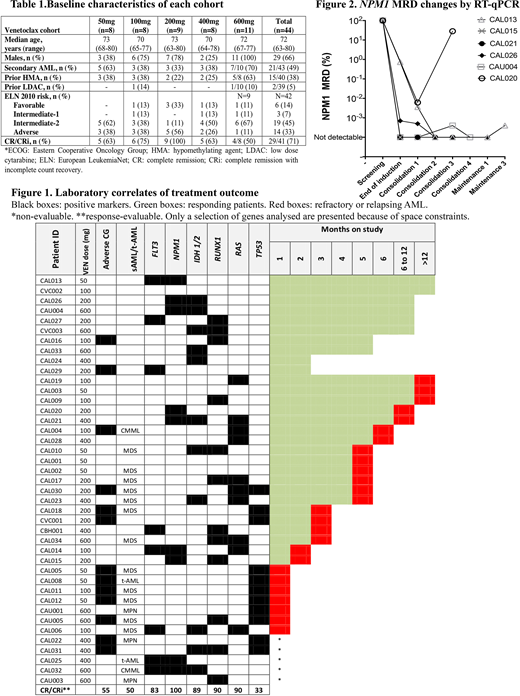Abstract

Background: Venetoclax (VEN) is a potent small molecule BH3-mimetic drug that selectively targets the prosurvival protein BCL-2 and has an emerging role for treatment in Acute Myeloid Leukaemia (AML). This ongoing Phase 1b study aims to evaluate the optimal dose, safety and efficacy of VEN in combination with modified intensive chemotherapy in fit, elderly patients with AML who have not received prior induction chemotherapy. Here we present updated data including molecular correlates of response and treatment outcomes.
Methods:Eligibility: Patients were enrolled with AML (excluding APL), age ≥65 years (≥60 years if monosomal karyotype), ECOG 0-1 and adequate organ function. Prior HMA/LDAC was permitted after a 14-day washout. Treatment: 1) Dose escalation cohorts comprised VEN 50mg (Cohort A), 100mg (B), 200mg (C), 400mg (D) or 600mg (E); 2) a 7-day VEN pre-phase incorporating dose ramp-up to minimise tumour lysis risk followed by a 7-day overlap with chemotherapy (day -6 to +7); 3) attenuated induction chemotherapy with cytarabine 100mg/m2/day IVI d1-5 staggered with idarubicin 12mg/m2 IV d2-3. For patients in remission, 4 cycles of consolidation were administered, comprising 14 days of VEN (day -7 to +7) with bolus cytarabine (100mg/m2/day IV d+1-2) and idarubicin (12mg/m2 IV d+1) followed by 7 cycles of VEN monotherapy maintenance; planned to commence q28d. Antifungal azoles were avoided during VEN exposure. The first patient was enrolled 17JUL2016. Molecular studies- Next generation sequencing using a 54-gene TruSight myeloid panel was performed on baseline bone marrow samples. FLT3-ITD testing was performed by capillary electrophoresis. RT-qPCR was used to detect minimal residual disease (MRD) in NPM1-mutated cases (assay sensitivity: 10-5-10-6).
Results: The data cut-off date was 13JUL2018. 44 patients were enrolled with 3 patients still in the induction cycle. Median age was 72 years (range 63-80 years; 23% ≥75 years), 66% of patients were male, 41% had secondary AML and 38% prior hypomethylating agent (HMA) exposure. Main grade ≥3 non-haematological adverse events during induction were febrile neutropenia (56%), sepsis (32%), rapid atrial fibrillation (15%), diarrhoea (12%), nausea (10%) and localised infection (10%). No clinical TLS was observed. One hematologic dose-limiting toxicity was reported in cohort E (VEN 600mg), but a maximum tolerated dose has not been reached. We observed progressive delay in platelet count recovery as patients proceeded with each cycle of therapy (median time to platelets ≥50x109/L was 25d in induction, 37d in consolidation 1 and 57d in consolidation 4). Treatment-related mortality was 7% in induction. 18/38 (47%) had ≥30% relative reduction in bone marrow (BM) blasts after 7 days of pre-phase VEN monotherapy, with no correlation between VEN dosage and the degree of BM blast reduction.
Overall CR/CRi rate was 71%. CR/CRi was achieved in 95% of patients with de novo AML (vs 42% in secondary/therapy-related AML). Response rates were 88% in intermediate vs 46% in adverse cytogenetic risk AML. Responses in patients with prior HMA therapy were 43% and 84% for previously untreated patients. Molecular data were available for 41 patients. 98% had ≥1 mutation detected. (Figure 1) Responses in response-evaluable patients were most common in NPM1 mutant AML (100%; n=7), followed by RUNX1 (90%; n=11), RAS (90%; n=10) and IDH (89%; n=9). Lowest responses were observed in TP53 mutant AML (33%; n=9). NPM1 MRD assessment was performed on 6 patients, of which 5 (83%) achieved NPM1 MRD negativity. (Figure 2) Updated response, response duration and survival data will be presented, along with molecular characteristics of relapse.
Conclusion: To date, VEN up to 600mg in combination with 5+2 induction chemotherapy is tolerable in fit elderly patients with AML. Initial response rates >80% were observed in de novo AML, as well as NPM1, RUNX1, RAS and IDH mutant AML, whereas responses were lower in patients with prior HMA exposure, adverse karyotype, secondary and TP53 mutant AML. Molecular determinants of relapse require further study.
Wei:Servier: Consultancy, Honoraria, Other: Advisory committee, Research Funding; Amgen: Honoraria, Other: Advisory committee, Research Funding; Novartis: Honoraria, Other: Advisory committee, Research Funding, Speakers Bureau; Pfizer: Honoraria, Other: Advisory committee; Celgene: Honoraria, Other: Advisory committee, Research Funding; Abbvie: Honoraria, Other: Advisory board, Research Funding, Speakers Bureau. Fong:Celgene: Other: Advisory board; Novartis: Other: Advisory board; Amgen: Research Funding; Pfizer: Other: Speaker fees. Reynolds:Novartis: Equity Ownership, Other: former employee of Novartis AG and holds stock in the company. . Roberts:Janssen: Research Funding; AbbVie: Research Funding; Genentech: Research Funding; Walter and Eliza Hall: Employment, Patents & Royalties: Employee of Walter and Eliza Hall Institute of Medical Research which receives milestone and royalty payments related to venetoclax.
Author notes
Asterisk with author names denotes non-ASH members.

This icon denotes a clinically relevant abstract


This feature is available to Subscribers Only
Sign In or Create an Account Close Modal